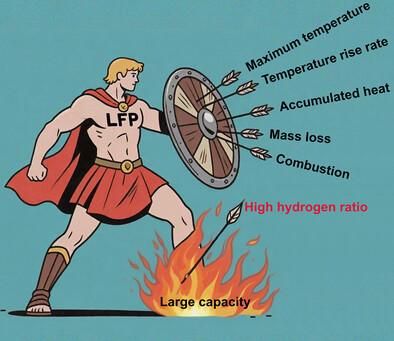Emerging Thermal Safety Characteristics of Large-Capacity Lithium Iron Phosphate Lithium-Ion Batteries
IF 26
1区 材料科学
Q1 CHEMISTRY, PHYSICAL
引用次数: 0
Abstract
Lithium iron phosphate is generally considered to be one of the most thermally stable cathode materials for commercial lithium-ion batteries, while emerging thermal safety characteristics rise with the large-capacity lithium-ion batteries in large-scale stationary energy storage power stations. In this review, different safety risks of lithium iron phosphate batteries compared with lithium nickel manganese cobalt oxide batteries from the view of general features of thermal runaway and the content of extremely dangerous hydrogen are discussed, especially the emerging thermal safety characteristics for large-capacity lithium-ion batteries. First, the prevailing belief that lithium iron phosphate is safer than lithium nickel manganese cobalt oxide is discussed based on the general features of thermal runaway, including characteristic temperature, heat generation, mass loss, and combustion possibility. Second, the rising viewpoint that the hydrogen content in the thermal runaway of lithium iron phosphate batteries is higher than that of lithium nickel manganese cobalt oxide batteries is examined. More importantly, different thermal behaviors are strongly related to the battery capacity (ampere hour). Additionally, the solutions to reduce hydrogen generation in lithium-ion batteries are presented in the outlook. This review presents comprehensive insights into the thermal safety behaviors of the commercial lithium-ion batteries with lithium iron phosphate cathodes.

大容量磷酸铁锂电池新出现的热安全特性
磷酸铁锂通常被认为是商用锂离子电池最稳定的正极材料之一,而随着大型固定式储能电站大容量锂离子电池的兴起,热安全特性也逐渐显现。本文从热失控的一般特征和极危险氢含量的角度,讨论了磷酸铁锂电池与镍锰钴氧化锂电池的不同安全风险,特别是大容量锂离子电池出现的热安全特征。首先,基于热失控的一般特征,包括特征温度、产热、质量损失和燃烧可能性,讨论了普遍认为磷酸铁锂比镍锰钴锂更安全的观点。其次,考察了磷酸铁锂电池热失控氢含量高于镍锰钴锂电池热失控氢含量的新观点。更重要的是,不同的热行为与电池容量(安培小时)密切相关。此外,展望中还提出了减少锂离子电池产氢的解决方案。本文综述了商用磷酸铁锂阴极锂离子电池的热安全性能。
本文章由计算机程序翻译,如有差异,请以英文原文为准。
求助全文
约1分钟内获得全文
求助全文
来源期刊

Advanced Energy Materials
CHEMISTRY, PHYSICAL-ENERGY & FUELS
CiteScore
41.90
自引率
4.00%
发文量
889
审稿时长
1.4 months
期刊介绍:
Established in 2011, Advanced Energy Materials is an international, interdisciplinary, English-language journal that focuses on materials used in energy harvesting, conversion, and storage. It is regarded as a top-quality journal alongside Advanced Materials, Advanced Functional Materials, and Small.
With a 2022 Impact Factor of 27.8, Advanced Energy Materials is considered a prime source for the best energy-related research. The journal covers a wide range of topics in energy-related research, including organic and inorganic photovoltaics, batteries and supercapacitors, fuel cells, hydrogen generation and storage, thermoelectrics, water splitting and photocatalysis, solar fuels and thermosolar power, magnetocalorics, and piezoelectronics.
The readership of Advanced Energy Materials includes materials scientists, chemists, physicists, and engineers in both academia and industry. The journal is indexed in various databases and collections, such as Advanced Technologies & Aerospace Database, FIZ Karlsruhe, INSPEC (IET), Science Citation Index Expanded, Technology Collection, and Web of Science, among others.
 求助内容:
求助内容: 应助结果提醒方式:
应助结果提醒方式:


